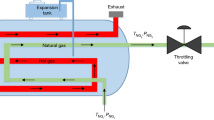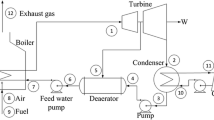Abstract
The present work aims to achieve the optimal solutions in synthesis and design levels for absorption chillers involving waste heat recovery (WHR) with repowering and cooling applications on reciprocating Wärtsilä diesel internal combustion engine (ICE) of 9 MW. The methodology is based on superstructure optimization approach, allowing to define the best configuration and finest parametric variables. This work presents separately three independent superstructures; single-effect powered by hot water or exhaust gases and double-effect powered by exhaust gases. In particular, absorption chillers can provide a chilled water system whose applications on Viana thermoelectric power plant might be performed through the installation of heat exchangers on radiator’s downstream, air conditioning systems and on the intake air of the engine. Therefore, allowing a reduction on electrical energy demand, brake specific fuel consumption and levering the brake shaft power output. A comparison is carried out between the three optimal configurations in terms of thermoeconomic parameters. The best optimal solution in means of highest profit is the hot water single-effect absorption chiller with solution heat exchanger in its structure. For instance, the profit of this optimal solution is US$ 4.75 per hour, which presents a total cost of investment of US$ 588,252.00 and a chilled water specific unit cost of US$ 2523.00 per ton. The benefit is calculated by using International Organization for Standardization documents which gives an amount of additional power output of 45.142 kW (0.517\(\%\)) with a reduction on brake specific fuel consumption around 1.282 g kWh−1 (0.646\(\%\)). The absorption chiller also reduces energy demand at radiator, resulting in 39.719 kW of savings.











Similar content being viewed by others
Abbreviations
- A :
-
Heat transfer area
- AC:
-
Air conditioning
- Ar:
-
Argon
- b :
-
Splitting
- BSFC:
-
Brake specific fuel consumption
- C :
-
Chilled water specific cost
- CC:
-
Cooling coil
- CEPCI:
-
Chemical engineering plant cost index
- CHP:
-
Cooling, heating and power
- CI:
-
Cost index
- \(\mathrm{CO}_2\) :
-
Carbon dioxide
- COP:
-
Coefficient of performance
- CR:
-
Control room
- CRF:
-
Capital recovery factor
- CT:
-
Cooling tower
- CVU:
-
Variable cost per unit
- CwAuHX:
-
Chilled water auxiliary heat exchanger
- \(\varDelta \) :
-
Variation or difference
- \(\epsilon \) :
-
Effectiveness
- EES:
-
Engineering equation solver
- h :
-
Specific enthalpy
- Hp:
-
High pump
- HX:
-
Heat exchanger
- \(\mathrm{H}_2\)O:
-
Water
- ICE:
-
Internal combustion engine
- \(i_{\mathrm{eff}}\) :
-
Effective interest rate
- ISO:
-
International organization for standardization
- K :
-
Proportional weighted constant
- LHV:
-
Lower heating value
- LMTD:
-
Log mean temperature difference
- Lp:
-
Low pump
- LV:
-
Low voltage room
- m :
-
Equipment’s coefficient
- \(\dot{m}\) :
-
Mass flow rate
- n :
-
Number of ...
- N :
-
Rotation speed
- \(\mathrm{N}_2\) :
-
Nitrogen
- o :
-
Equipment’s coefficient
- \(\mathrm{O}_2\) :
-
Oxygen
- \(\mathrm{OF}\) :
-
Objective function
- ORC:
-
Organic Rankine cycle
- \(\dot{P}\) :
-
Profit rate
- \(\%\) :
-
Percentage value
- \(\phi _{\mathrm{main}}\) :
-
Maintenance coefficient
- PR:
-
Pressure ratio
- Q :
-
Volumetric flow rate
- \(\dot{Q}\) :
-
Heat rate
- \(\dot{R}\) :
-
Revenue rate
- \(\rho \) :
-
Density
- \(\mathrm{SO}_2\) :
-
Sulphur dioxide
- \(\sum \) :
-
Sum
- T :
-
Temperature
- TCI:
-
Total cost of investment
- U :
-
Global heat transfer coefficient
- \(\dot{W}\) :
-
Work rate
- WHR:
-
Waste heat recovery
- x :
-
Solution mass fraction
- X :
-
Parameter of interest
- Z :
-
Purchase cost
- \(\dot{Z}\) :
-
Cost rate
- a:
-
Air stream
- ART:
-
Artificial
- cw:
-
Chilled water
- eff:
-
Effective
- ele:
-
Electric
- em:
-
Electric motor
- exp:
-
Expansion
- f:
-
Fuel
- i :
-
Index
- in:
-
Inlet
- lm:
-
Log mean
- main:
-
Maintenance
- max:
-
Maximum
- min:
-
Minimum
- ope:
-
Operation
- ou:
-
Outlet
- p:
-
Pump
- rad:
-
Radiator
- ref:
-
Reference
References
Frangopoulos CA, Spakovsky MRV, Sciubba E (2002) A brief review of methods for the design and synthesis optimization of energy systems. Int J Thermodyn 5:151–160
Alcântara SCS, Ochoa AAV, da Costa JAP, Michima PSA, Silva HCN (2019) Natural gas based trigeneration system proposal to an ice cream factory: an energetic and economic assessment. Energy Convers Manag. https://doi.org/10.1016/j.enconman.2019.111860
Gbemi O, Jobson M, Smith R, Perry SJ (2015) Evaluating the potential of process sites for waste heat recovery. Appl Energy 161:627–646. https://doi.org/10.1016/j.apenergy.2015.07.011
Gbemi O, Jobson M, Smith R (2015) A hierarchical approach for evaluating and selecting waste heat utilization opportunities. Energy 90:5–23. https://doi.org/10.1016/j.energy.2015.05.086
Morawski AP, Araújo LR, Cunha CCM, Donatelli JLM, Santos JJCS (2017) Comparison of the repowering alternatives technologies for waste heat recovery in a diesel engine power plant. In: ECOS 2017 proceedings of the 30th international conference on efficiency, cost, optimization, simulation and environmental impact of energy systems
Souza RJ, Dos Santos CAC, Ochoa AAV, Marques AS, Neto JLM, Michima PSA (2020) Proposal and 3E (energy, exergy, and exergoeconomic) assessment of a cogeneration system using an organic Rankine cycle and an absorption refrigeration system in the Northeast Brazil: Thermodynamic investigation of a facility case study. Energy Convers Manag. https://doi.org/10.1016/j.enconman.2020.113002
Herold KE, Radermacher R, Klein SA (2016) Absorption chillers and heat pumps. CRC Press, Boca Raton
ASHRAE (2014) Refrigeration. ASHRAE Handbook, Atlanta
Chun A (2017) Otimização de uma superestrutura de chillers por absorção para a recuperação de calor Residual em motores de combustão interna. Universidade Federal do Espírito Santo (In Portuguese), Trabalho de Conclusão de Curso
Chun A, Morawski AP, Araújo LR, Oliveira RCL, Barone MA, Schiaffino M, Donatelli JLM, Santos JJCS, Cunha CCM, Valiati AS (2018) Thermoeconomic optimization of absorption chiller superstructures for an internal combustion engine; waste heat recovery and cold-water applications. In: International conference of thermal science (ENCIT 2018)
Henao CA (2012) A superstructure modeling framework for process synthesis using surrogate models. Doctoral thesis, The University of Wisconsin-Madison
Barnicki SD, Siirola JJ (2004) Process synthesis prospective. Comput Chem Eng 28:441–446. https://doi.org/10.1016/j.compchemeng.2003.09.030
Liu P, Georgiadis MC, Pistikopoulos EN (2011) Advances in energy systems engineering. Ind Eng Chem Res ACS Publ 50:4915–4926. https://doi.org/10.1021/ie101383h
Mencarelli L, Chen Q, Pagot A, Grossmann IE (2020) A review on superstructure optimization approaches in process system engineering. Comput Chem Eng 19:S0098-1354. https://doi.org/10.1016/j.compchemeng.2020.106808
Alefeld G, Radermacher R (1993) Heat conversion systems. CRC Press, Boca Raton
Bertran M-O, Frauzem R, Sanchez-Arcilla A-S, Zhang L, Woodley JM, Gani R (2017) A generic methodology for processing route synthesis and design based on superstructure optimization. Comput Chem Eng 106:892–910. https://doi.org/10.1016/j.compchemeng.2017.01.030
Yu H, Eason J, Biegler LT, Feng X (2017) Process integration and superstructure optimization of Organic Rankine Cycles (ORCS) with heat exchanger network synthesis. Comput Chem Eng 107:257–270. https://doi.org/10.1016/j.compchemeng.2017.05.013
Maia L, Carvalho LVD, Qassim R (1995) Synthesis of utility systems by simulated annealing. Comput Chem Eng 19:481–488. https://doi.org/10.1016/0098-1354(94)00061-R
Donatelli JLM (2002) Otimização estrutural e paramétrica de sistemas de cogeração utilizando superestruturas. Tese (Doutorado), COPPE/Universidade Federal do Rio de Janeiro (In Portuguese)
Koch C, Cziesla F, Tsatsaronis G (2007) Optimization of combined cycle power plants using evolutionary algorithms. Chem Eng and Process 46:1151–1159. https://doi.org/10.1016/j.cep.2006.06.025
Bouvy C, Lucas K (2007) Multicriterial optimisation of communal energy supply concepts. Energy Convers Manag 48:2827–2835. https://doi.org/10.1016/j.enconman.2007.06.046
Voll P, Lampe M, Wrobel G, Bardow A (2012) Superstructure-free synthesis and optimization of distributed industrial energy supply systems. Energy 45:424–435. https://doi.org/10.1016/j.energy.2012.01.041
Wang L, Voll P, Lampe M, Yang Y, Bardow A (2015) Superstructure-free synthesis and optimization of thermal power plants. Energy 91:700–711. https://doi.org/10.1016/j.energy.2015.08.068
Wang L, Yang Y, Dong C, Morosuk T, Tsatsaronis G (2014) Parametric optimization of supercritical coal-fired power plants by MINLP and differential evolution. Energy Convers Manag 85:828–838. https://doi.org/10.1016/j.enconman.2014.01.006
Klein S, Nellis G (2012) Mastering EES. f-Chart software
EES (2017) Engineering equation solver-EES
Dixit M, Arora A, Kaushik SC (2017) Thermodynamic and thermoeconomic analyses of two stage hybrid absorption compression refrigeration system. Appl Therm Eng 113:120–131. https://doi.org/10.1016/j.applthermaleng.2016.10.206
Moran MJ, Shapiro HN, Boettner DD, Mailey MB (2013) Fundamentals of engineering thermodynamics. Wiley, Cambridge
More AJ (2015) 40 lessons on refrigeration and air conditioning from IIT kharagpur. IIT Kharagpur, Kharagpur
Fox RW, Pritchard PJ, McDonald AT (2012) Introdução à Mecânica dos Fluidos. Grupo Gen-LTC, Rio de Janeiro (In Portuguese)
Ribeiro CC (2015) Desenvolvimento de um Sistema de Informação para Monitoramento e Diagnóstico de Desempenho Termodinâmico de uma Central Termelétrica com Motores de Combustão Interna. Dissertação de Mestrado (In Portuguese)
ISO 15550 (2002) International organization for standardization-internal combustion engines: determination and method for the measurement of engine power-general requirements. Geneve, Switzerland
ISO 3046–1 (2002) International Organization for Standardization-Reciprocating internal combustion engines—performance, part 1. Geneve, Switzerland
Boehm RF (1987) Design analysis of thermal systems. Wiley, New York
Bejan A, Tsatsaronis G, Moran M (1996) Thermal design and optimization. Wiley, New York
D’Accadia MD, Rossi FD (1998) Thermoeconomic optimization of a refrigeration plant. Int J Refrig 21:42–54. https://doi.org/10.1016/S0140-7007(97)00071-6
Misra RD, Sahoo PK, Gupta A (2005) Thermoeconomic evaluation and optimization of a double-effect H2O/LiBr vapour-absorption refrigeration system. Int J Refrig 28:331–343. https://doi.org/10.1016/j.ijrefrig.2004.09.006
Misra RD, Sahoo PK, Sahoo S, Gupta A (2003) Thermoeconomic optimization of a single effect water/libr vapour absorption refrigeration system. Int J Refrig 26:158–169. https://doi.org/10.1016/S0140-7007(02)00086-5
Christian J (1977) Central cooling: absorptive chillers. U.S. energy research and development administration. Oak Ridge National Laboratory
CEPCI (2018) Economic indicators https://www.chemengonline.com/site/plant-cost-index/. Accessed Oct 05
Vatavuk WM (2001) Updating the CE plant cost index. Chem Eng 109:62–70
Castillo JCÁ (2007) Cost estimation of using an absorption refrigeration system with geothermal energy for industrial applications in el Salvador. United Nations University, Iceland
Lapponi JC (2000) Projetos de investimento: construção e avaliação do fluxo de caixa. Lapponi, São Paulo ( (In Portuguese))
Metcalfe T (2018) MPIKAIA - Parallel Genetic Algorithm
Metcalfe TS, Charbonneau P (2003) Stellar structure modeling using a parallel genetic algorithm for objective global optimization. J Comput Phys 185:176–193. https://doi.org/10.1016/S0021-9991(02)00053-0
De Jong KA (1975) Analysis of the behavior of a class of genetic adaptive systems. University of Michigan, Ann Arbor
Goldberg DE (1989) Genetic algorithms in search, optimization, and machine learning. Addison Wesley Publishing Company, Boston
Amir V (1975) Optimization the rankine cycle with genetic algorithm. In: Proceedings of the 2nd international conference on mechanical, production and automobile engineering (ICMPAE’2012)
Acknowledgements
The authors are grateful to the Program of Research and Development of the Electric Energy Sector regulated by the Brazilian Electricity Regulatory Agency (ANEEL), Coordination for the Improvement of Higher Education Personnel (CAPES), Support Foundation Espírito Santo Research (FAPES), Termelétrica Viana S.A. (TEVISA) which provided financial support for the R&D project.
Author information
Authors and Affiliations
Corresponding author
Ethics declarations
Conflicts of interest
The authors declare that they have no conflict of interest.
Additional information
Technical Editor: Monica Carvalho, PhD.
Publisher's Note
Springer Nature remains neutral with regard to jurisdictional claims in published maps and institutional affiliations.
Rights and permissions
About this article
Cite this article
Chun, A., Morawski, A.P., Barone, M.A. et al. Superstructures optimization of absorption chiller for WHR of ICE aiming power plant repowering and air conditioning. J Braz. Soc. Mech. Sci. Eng. 43, 135 (2021). https://doi.org/10.1007/s40430-021-02872-2
Received:
Accepted:
Published:
DOI: https://doi.org/10.1007/s40430-021-02872-2




